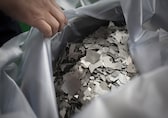Summary
The Electronics Industries Association of India (ELCINA) has cautioned that over 5,0006,000 direct jobs and nearly 15,000 indirect jobs, mainly in Noida and southern India, are at risk.
Source: Moneycontrol

AI News Q&A (Free Content)
Q1: What are rare-earth elements, and why are they crucial for the electronics supply chain?
A1: Rare-earth elements (REE) are a group of 17 metals crucial for manufacturing electronic components, including those in smartphones, TVs, and audio equipment. Despite the name, these elements are relatively abundant in the Earth's crust but are usually dispersed, making extraction costly. Their unique properties make them indispensable in producing high-tech devices and industrial processes.
Q2: How do China's rare-earth export restrictions impact the global electronics industry?
A2: China's restrictions on rare-earth exports could significantly impact the global electronics supply chain. As a leading producer, China's policies can influence supply stability and prices, potentially leading to higher costs for electronic goods and risking thousands of jobs, particularly in regions like India where electronics manufacturing is concentrated.
Q3: What initiatives is China implementing to reduce its reliance on foreign technology and materials?
A3: China's 'Made in China 2025' plan is a strategic initiative to transform its manufacturing industry into a more technology-intensive powerhouse. The plan aims to increase domestic content in core materials and reduce reliance on foreign technology by investing in high-tech industries, including semiconductors, to drive innovation and economic growth.
Q4: What recent advancements have been made in the sustainable recovery of rare-earth elements?
A4: Recent studies have proposed more sustainable methods for recovering rare-earth elements from secondary sources like phosphogypsum waste. These methods aim to reduce environmental impact and improve economic viability, with techniques like bio-inspired adsorptive separation showing promise in achieving high purity rare-earth streams.
Q5: How do rare-earth elements contribute to the functionality of modern electronics?
A5: Rare-earth elements are integral to modern electronics, serving as key components in magnets, batteries, and other essential parts. Their unique magnetic and conductive properties are vital for the miniaturization and efficiency of electronic devices, enabling advancements in technology and innovation.
Q6: What are the economic implications of China's rare-earth element export curbs?
A6: China's export curbs on rare-earth elements could lead to increased global prices and supply disruptions, affecting industries reliant on these materials. This situation may force companies to seek alternative suppliers or invest in the development of domestic rare-earth sources, impacting global trade dynamics and economic strategies.
Q7: What are the potential environmental benefits of advancing rare-earth element recovery technologies?
A7: Advancing rare-earth element recovery technologies could significantly reduce the environmental impact associated with traditional mining and processing methods. By utilizing waste materials and improving extraction efficiency, these technologies can decrease pollution, lower energy consumption, and contribute to a more sustainable supply chain.
References:
- Rare-earth element
- Made in China 2025
- Advancing the Economic and Environmental Sustainability of Rare Earth Element Recovery from Phosphogypsum




